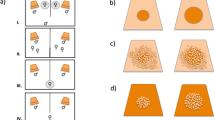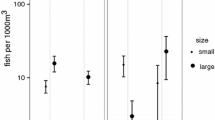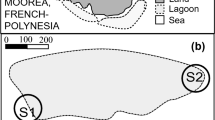Summary
Although a few male longear sunfish nest solitarily, most territorial males excavate their nest in dense aggregations. The importance of sexual selection in the evolution of this breeding system was evaluated by 1) examining the influence of certain male and nest characteristics on spawning success and 2) by comparing the success of social and solitary nesters. Among group nesters, females spawned preferentially with males nesting early within a spawning period and occupying central nests. Male size and nest diameter were negatively correlated with nesting day and hence spawning success. However, female discrimination using these traits directly could not be demonstrated. The reproductive success of social and solitary males was compared by counting the larvae in their nests several days after spawning. Successful males (with larvae) were more likely than males without larvae to be encountered later in the breeding season and to nest in small groups or solitarily. Spawning period (of which there were 5 or 6 in a season) was significantly correlated with larval abundance in the nest, while male size was not. Social and solitary males were equally successful, but aggregations may nonetheless result from sexual selection: males unlikely to attract females may nest around more attractive males to steal fertilizations from them. High spawning synchrony may prevent attractive males from renesting elsewhere once other nesters aggregate around them.
Similar content being viewed by others

References
Bietz BF (1980) The adaptive significance of territorial aggregation in longear sunfish (Lepomis megalotis peltastes Cope). PhD Thesis, University Western Ontario, London, Canada, p 126
Bietz BF (1981) Habitat availability, social attraction and nest distribution patterns in longear sunfish (Lepomis megalotis peltastes). Eny Biol Fish 6:193–200
Borgia G (1979) Sexual selection and the evolution of mating systems. In: Blum MS, Blum NA (eds) Sexual selection and reproductive competition in insects. Academic Press, New York, pp 19–80
Breder CM (1936) The reproductive habits of the North American sunfishes (Family Centrarchidae). Zoologica 21:1–48
Breder CM, Rosen DE (1966) Modes of reproduction in fishes. Natural History Press, Garden City, New York, p 941
Cohen E, Burns P (1977) SPSS Manova-Multivariate analysis of variance and covariance. Northwestern University, Evanston, Illinois, p 154
Cohen JA (1984) Sexual selection and the psychophysics of female choice. Z Tierpsychol 64:1–8
Dominey WJ (1981) Anti-predator function of bluegill sunfish nesting colonies. Nature 290:586–588
Dupuis HMC (1985) Factors influencing reproductive success of nesting male longear sunfish (Lepomis megalotis peltastes). PhD Thesis, University Western Ontario, London Canada, p 109
Emlen ST, Oring LW (1977) Ecology, sexual selection, and the evolution of mating systems. Science 197:215–223
Grant PR (1968) Polyhedral territories of animals. Am Nat 102:75–80
Gross MR, MacMillan AM (1981) Predation and the evolution of colonial nesting in bluegill sunfish (Lepomis macrochirus). Behav Ecol Sociobiol 8:163–174
Huck LL, Gunning GE (1967) Behavior of the longear sunfish, Lepomis megalotis (Rafinesque). Tulane Stud Zool 14:121–131
Itzkowitz M (1978) Group organization of a territorial damselfish, Eupomacentrus planifrons. Behaviour 65:125–137
Janetos AC (1980) Strategies of female choice: a theoretical analysis. Behav Ecol Sociobiol 7:107–112
Keenleyside MHA (1972) Intraspecific intrusions into nests of spawning longear sunfish (Pisces, Centrarchidae). Copeia 1972:272–278
Kodric-Brown A (1981) Variable breeding systems in pupfishes (Genus Cyprinodon): adaptations to changing environments. In: Naiman RJ, Soltz DL (eds) Fishes in North American deserts. Wiley & Sons, New York, pp 205–235
Lill A (1974) Sexual behavior of the lek-forming white-bearded manakin (Manacus manacus trinitatis). Z Tierpsychol 36:1–36
Nie NH, Hull CH, Jenkins JG, Steinbrenner K, Bent DH (1975) Statistical package for the social sciences. 2nd edn. McGraw-Hill, New York, p 675
Noltie DB (1982) The reproductive ecology and behaviour of stream-dwelling rock bass, Ambloplites rupestris (Rafinesque). MSc Thesis, University Western Ontario, London, Canada, p 242
Noltie DB, Keenleyside MHA (1986) Correlates of reproductive success in stream-dwelling male rock bass, Ambloplites rupestris (Centrarchidae). Env Biol Fish 17:61–70
Tabachnik BG, Fidell LS (1983) Using multivariate statistics. Harper & Row, New York, p 509
Ward P, Zahavi A (1973) The importance of certain assemblages of birds as ‘information-centres’ for food finding. Ibis 115:517–534
Warntz W (1964) A new map surface of population potentials for the United States, 1960. Geogr Rev 54:170–184
Wilson EO (1975) Sociobiology — The new synthesis. Belknap Press, Harvard, p 697
Wittenberger JF (1978) The evolution of mating systems in grouse. Condor 80:126–137
Wittenberger JF (1983) Tactics of mate choice. In: Bateson P (ed) Mate choice. Cambridge University Press, Cambridge, pp 435–447
Zar JH (1984) Biostatistical analysis, 2nd edn. Prentice-Hall, Englewood Cliffs, p 718
Author information
Authors and Affiliations
Rights and permissions
About this article
Cite this article
Dupuis, H.M.C., Keenleyside, M.H.A. Reproductive success of nesting male longear sunfish (Lepomis megalotis peltastes). Behav Ecol Sociobiol 23, 109–116 (1988). https://doi.org/10.1007/BF00299894
Received:
Accepted:
Issue Date:
DOI: https://doi.org/10.1007/BF00299894



